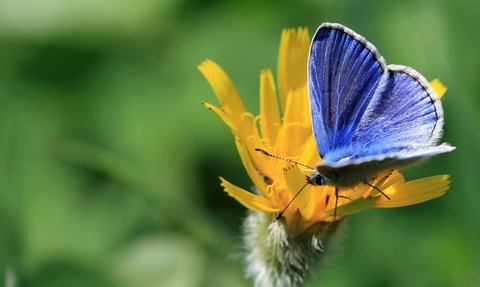
Common Blue (c) Vicky Nall
Become a dragonfly expert and try some beautiful butterfly crafts!
Discover dragonflies
Let us tell you something cool: Dragonflies have been around for over 300 million years – longer than humans! They really are fascinating creatures to spot and learn about. Did you know that they are one of our most successful predators, that they can move like a helicopter or that their eyes take up most of their head? It doesn’t stop there, there is plenty more to discover…and the good news is that dragonflies can be spotted in lots of different places, from ditches to ponds so and look out for them wherever you go!
Hunt for Dragons! Get your gang together and enjoy a trip to a habitat where you are sure to spot a range of species and enjoy the clatter of walking on a boardwalk whilst you’re at it!
Go here:
- Panshanger Park, near Welwyn Garden City, is home to Hertfordshire’s first Dragonfly Hotspot – with a variety of species, easy access for visitors and opportunities to learn more about these amazing creatures, it’s a great place to start your dragonfly adventure.
- Check out the Trust’s super Dragonfly Trail at Amwell Nature Reserve – it’s home to 21 species of dragonflies and damselflies but you’ll have to go at different times in the year to spot them all!
Become a dragonfly and damselfly expert
Read this:
- Packed with great tips on what to look for and where, the Trust’s blog ‘Six Dragonflies and Damselflies to Spot over Summer’ will allow you to impress your friends with your new knowledge!
- Explore the different species of dragonflies and damselflies and fascinating facts about them on the Wildlife Explorer pages of the Trust’s website.
Dazzling dragonfly crafts and awesome activities
Make this:
- Feeling crafty? Draw or paint dragonflies and damselflies or make mobile decorations for your home or garden, using Sycamore seeds and twigs, along with some craft materials – here’s how.
- Create a mini pond to attract dragonflies to your outside space and it won’t be long before you see it buzzing with wildlife – find out how here.
Beautiful butterflies
As the summer days warm up, butterflies emerge and we see more of them flying and feeding on the nectar provided by flowering plants. It’s the perfect time of year to go on a butterfly hunt and enjoy the grace and beauty of these wonderful creatures.
Read this:
- Discover some of our more common butterfly species in the Trust’s blog ‘Summer Butterflies’.
Do this:
- Gather your friends and family for a project to create your very own butterfly garden – it might take some time and effort but it will be so worth it. This guide names plants which will attract butterflies in the different seasons - you’ll find that bees love them too! As you start to plan your garden, remember that butterflies like warmth and the plants that they feed from are also sun lovers, so it makes sense to plant flowering plants in a sunny spot, where they are sheltered from wind. Butterflies have sensors on their antennae, legs and feet and they can sense the smell of flowers and also whether they can eat their nectar. Flower colour is also important for butterflies’ diets - different species prefer different colours and tastes – purple, yellow and red flowers are most popular. When planning a butterfly garden, plant a mixture of colourful plants that flower at different times to create the best butterfly garden and to encourage a variety of butterflies to visit. You could start with a drawing of your garden and get everyone involved in adding their thoughts to the plan.
Flit around with butterfly crafts
Make this:
- Create a fabulous butterfly mask – you could take a look at different species of butterflies on the Trust’s Wildlife Explorer pages for ideas on how to decorate it.
- A model butterfly makes a wonderful gift for a friend or family member, and it can be hung up for everyone to admire.
Meet some minibeasts!
Summer is a great time to get to know some of our smallest species. Minibeast is the nickname used to describe 'little creatures' but the proper, more scientific term is 'invertebrates' and it describes all creatures that do not have a back bone, including butterflies, bees, snails etc.
Do this:
- Use your investigative powers to find those pictured on the Trust’s Minibeast Detective Spotter Sheet.
- Count those spots carefully to hunt down the various ladybird species with the Trust’s Ladybird Spotter Sheet.
Get your outdoor space buzzing
Increasing the insects in your garden or community space will make it more valuable to wildlife in general as lots of birds and animals like to eat them!
Make this:
- Follow these step-by-step instructions on how to make a bee hotel and wait for rave reviews from its visitors!
- Create a bug mansion and get the creepy crawlies moving in!
